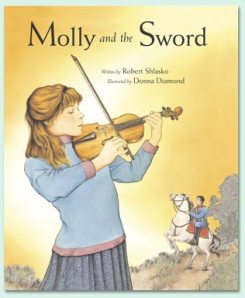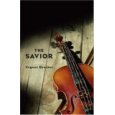Liesel Soley, a graduate of the Juilliard School of Music and Fulbright scholar in Paris, France, is a professional violinist. Soley has performed solo recitals in the U.S. and France and was the violinist in the piano trio, Trio Viva. She has taught violin at the Manhattan School of Music in New York City and violin and viola at St. Petersburg College and the Pinellas County Center for the Arts in St.Petersburg, Florida.
Presently, Liesel Soley shares her love for music with children, as well as adults in Clearwater, Florida where she teaches violin, viola, and chamber music privately and in an after-school program at Shorecrest Preparatory School in St. Petersburg.
 Soley has found a welcome relief from the very disciplined, intensive, and time-consuming work with the violin in her other artistic means of expression; writing, painting and drawing.
Soley has found a welcome relief from the very disciplined, intensive, and time-consuming work with the violin in her other artistic means of expression; writing, painting and drawing.
Congratulations on the publication of your children’s book, Can You Be an Artist? What got you into writing?
My first writing was when I was in Paris on a Fulbright Grant. I was struggling with the violin and life, and one day when it was very difficult to approach the violin, I just started to write some poetry with no expectations or standards to meet. This took place over a period of about two weeks. It was a kind of a relief and my morale went way up. The poems remained in my violin case for 44 years! I couldn’t quite throw them away.
Then several years ago my family requested I send them personal things I had created which resulted in putting together CDs of some of my solo violin and piano trio performances, a book of my paintings, and Yes! – those poems mentioned above along with some very short stories I wrote up about playing violin in the streets which I had been telling for years! Yes, even though I am a Juilliard graduate, I have hit the streets and had some interesting and fun experiences in the streets of New York, London, and Paris! Some of my friends look aghast at some of the things I do. I just laugh!
So, this brings me to the children’s book I just completed. During the summer some of my students disappear, going to camps and on vacation, so it was either do something creative or sit around and mope because of a lack of work.
“Can YOU Be an Artist?” came into being!
What was your inspiration for Can You Be an Artist?
Working with my violin students and seeing total transformations take place, sometimes quickly and sometimes over a period of years.The violin is extremely challenging and it takes tremendous discipline and persistence to play well. To see the confidence, the self-esteem, the growth of students developing as a result of participating in the arts is rewarding and exciting. Taking part in orchestras, recitals, and competitions can give such a sense of accomplishment to these youngsters. Although I have mostly seen this as a musician, I know that students in all the arts tend to excel in other areas as well, such as in school. Individuals who express themselves through the arts, who create, are happier and more successful. I know this with absolute certainty and wanted to express this.
What message you hope readers will get from your book?
As indicated in my authors note, one can create in many ways, “— If one truly creates beauty and quality in what one does and if this translates to others one is actively being an artist.”
Also – Dare To Follow Your Dreams! Dare To Be Yourself! Dare to Be Free!!
Tell us about what your writing process was like for this book. Did you outline it first? Did you edit it as you went along?
The structure, using the three different art forms and the three kids just popped up. I mocked it up very quickly. As I have a number of Korean students I wanted one of the kids to be Korean. Each child was very real to me. Because I was able to be Freddie, or Honey, or Bae it was easy to write their feelings, about their families etc. Using the first person for them seemed very natural.The few word changes or added took place after the writing was done as a whole.
You also illustrated the book. Give us a glimpse into the mind of the author/illustrator persona? Did you write the story first and later illustrate it?
The writing was done first although I had illustrations in mind. There was an original mock-up of the book with far fewer illustrations than in the completed published book. A number of people had commented that there were too few illustrations, too many words per page, that the colors were weak and there were not enough details for kids. I agreed, so the next summer (2010) I decided to handle the things that were not ok and complete the book.
It was very difficult for me. I added 12 more drawings and totally changed all the existing ones except for 2, and even those I had to do all over because the paper was different!
I would lie awake at night mocking up the next illustration – hardly slept for 2 months. I was excited and determined to finish within two months before the school season started. The work was intense. I mocked up the illustrations easily but when it came to the execution of the drawings in terms of enough color it drove me nuts. I would create the drawing rather quickly then invariably at a certain point I would have exactly what I wanted but not enough color and I would stop and move on to the next illustration! I did not have the certainty and courage to do full color right off! I was afraid I would mess up on those tiny little lines or dots or whatever, like with expressions on faces, and that I would have to do the whole picture over again!
O Man, I ended up going over these illustrations three times – the entire picture 3 times – each time adding another layer of color, each time in more agony than the previous time! It was awful! I was an idiot!
I am laughing at the whole experience. Not being trained in painting, drawing, or illustrating, this was more than a learning experience! It was literally painful! I was doing these drawings leaning over the dining room table with a lot of weight on my left arm and hand pressing down on the table while I meticulously (and gingerly!) proceeded to work with my right hand. A little before the end of the 2 months I felt like a cripple! I could not play the violin for over 2 weeks! Next time it is full color on the first shot!!! and with a decent set up!
What made you decide to publish your book with Book Publishers Network?
I had used a POD place for the book of my paintings and although I was very happy with the results it was a lot of keeping at it to get exactly what I wanted. For my book with the poems and short stories about playing in the streets I used Apple. It was nice – but expensive.
I wanted a publisher that had a team of experts, someone with whom I could communicate easily and someone who would get the job done quickly. Sheryn Hara with Book publishers Network had been recommended by an author/illustrator acquaintance as being very good for first time authors with plenty of experience and expertise and she really cared for her authors. She sent me samples of children’s books which I really liked. She was exactly what I wanted. She was hooked up with a fine printer so my book was completed!
Also, I wanted a wider audience for this book- not just family and friends.
What was the publishing process like?
Things moved along very well. Sometimes there would be suggestions but my needs and wants as an artist were totally respected. It was suggested I use some kind of border around the pictures and a number were shown to me but I really did not want that and that was totally accepted. I groaned when Sheryn Hara said the cover of the book which I had done needed to be jazzed up. I told her I did not want anyone else doing any of the art work. She immediately said none of the art work would be disturbed – just the background would be made more alive. I was sent a number of possibilities and love the one I chose. I find it very aesthetic and am glad my publisher pushed me in that respect.
I was glad not one word of my writing was changed. There would have been a fight if changes had been wanted. Punctuation had to be handled! No problem! Book Publishers Network is hooked up with a fine printer and the book was completed!
What is your schedule like? How do you balance your violinist, music instructor, artist, and writer personas?
At this time in my life I am primarily teaching violin, viola and chamber music, but my involvement in my other arts has increased considerably! I teach privately at my home 7 days a week and 3 afternoons in an after school program at Shorecrest . There are music teachers meetings to attend, and recitals and competitions to arrange. Add to that violin presentations and now book signings and work on PR. I also have arranged to have some of my young students perform at book stores and libraries where I have book signings. Things are busy! The short answer to your question is – I am very focused on what I am doing at any given moment, and I work hard 7 days a week. I thrive on lots of fast action!
Do you have tips for unleashing and nurturing one’s creativity?
Sure – find something you have really wanted to do and START! Be true to yourself, maintain your integrity and do not let others throw you. Go at your own pace, keep it light and have FUN! If it is not always fun -well, so what!
Are you working on another book? What’s on the horizon for you?
Not at the moment, but I have a couple in mind. I am not setting a timetable. I have a way of doing things spontaneously at the right time for me. The future looks interesting, challenging and fun. And there are definitely unknowns! I like it that way.
Is there anything else you’d like to tell readers?
Yes, I would love to hear from you – to know if my book has inspired you or your children or your grandchildren. Also, I would be delighted to have you visit my web site and be in communication with me.
 reviews from music and education magazines. Here to talk about the book is author Robert Shlasko.
reviews from music and education magazines. Here to talk about the book is author Robert Shlasko.



